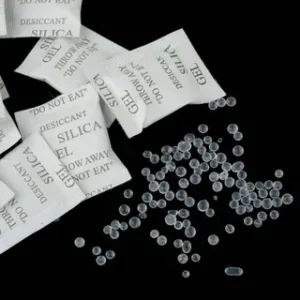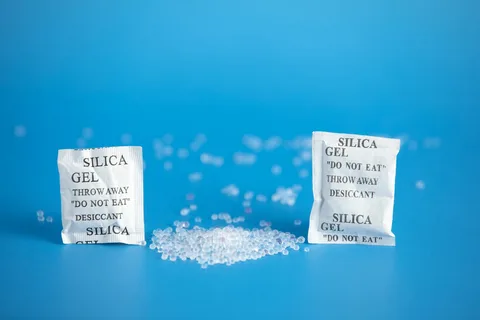Silica Gel Desiccants are crucial in maintaining the quality and shelf-life of various products during storage and transportation. Understanding the importance of these moisture-absorbing agents is vital to preserving goods in optimal conditions. In this guide, we will explore the factors to consider when choosing the best silica desiccants, the different types available, tips for storage and usage, benefits in various industries, common mistakes to avoid, and frequently asked questions to help you make informed decisions.
Understanding the Importance of Gel Desiccants
Gel desiccants, such as silica gel, are crucial in various applications due to their superior moisture-absorbing capabilities. These desiccants maintain a controlled environment by effectively capturing and holding moisture that could otherwise lead to degradation. For instance, gel desiccants are employed in vehicle interiors and storage in the automotive industry to prevent condensation that can cause rust and electrical issues.
By ensuring that the interior of a vehicle remains dry, these desiccants help maintain the vehicle’s condition and enhance its longevity. Gel desiccants play a significant role in preserving luxury goods and collectibles. High-end watches, fine jewellery, and rare collectibles are particularly susceptible to damage from moisture, which can lead to tarnishing or mould growth. Silica gel packets are often included in the packaging of these items to safeguard their condition.
By controlling the humidity levels inside the packaging, gel desiccants help maintain the pristine quality of these valuable items, thereby preserving their aesthetic appeal and investment value. Gel desiccants are also increasingly used in the construction and home improvement sectors. In construction projects, silica gel protects building materials such as cement, gypsum, and drywall from moisture during storage and transit. Excess humidity can compromise the integrity of these materials, leading to potential delays and increased costs.
Factors to Consider when Selecting Gel Desiccants
When selecting gel desiccants for your storage requirements, it is crucial to consider various key factors to guarantee the most effective moisture control. By taking the following aspects into account, you can ensure that your stored items remain in optimal condition for an extended period:
- Humidity Levels: One of the most important factors to consider when choosing gel desiccants is the relative humidity levels in the storage environment. Different types of gel desiccants are designed to absorb varying levels of moisture, so it is essential to select the right product based on the humidity levels in your specific storage area.
- Absorption Capacity: Another critical factor to consider is the absorption capacity of the gel desiccants. The absorption capacity determines how much moisture the desiccants can effectively absorb before needing to be replaced or regenerated. Choosing desiccants with a high absorption capacity is essential to ensure maximum moisture control.
- Size and Quantity: The size and quantity of gel desiccants needed for your storage requirements will depend on the size of the storage area and the amount of moisture present. Calculating the correct amount of desiccants required to effectively control moisture levels in your storage space is critical.
Applications of Silica Gel
Silica gel is incredibly versatile and finds applications across various industries thanks to its excellent moisture-absorbing properties. In the electronics industry, silica gel is commonly used to protect sensitive components from humidity and condensation, which can lead to corrosion and malfunction. Manufacturers and shippers often include silica gel packets in packaging to safeguard items such as cameras, mobile phones, and other electronic devices during transportation and storage. By maintaining a dry environment, silica gel ensures the longevity and reliability of these high-value products.
In the pharmaceutical and food industries, silica gel plays a crucial role in preserving the quality and efficacy of products. Medications, vitamins, and supplements are particularly vulnerable to moisture, which can cause chemical degradation, reduce shelf life, and compromise effectiveness. Including silica gel packets in packaging helps maintain optimal humidity levels, ensuring these products remain safe and effective for consumers.
The use of silica gel extends to various other sectors, including the leather and textile industries. Leather goods, such as shoes, bags, and jackets, are prone to mould and mildew when exposed to moisture. Silica gel packets placed inside these products or packaging can absorb excess humidity, preserving their appearance and structural integrity. In the textile industry, silica gel helps protect fabrics and garments during storage and shipping by preventing dampness and musty odours.
Different Types of Gel Desiccants Available
Gel desiccants are commonly used in various applications because they effectively absorb moisture. They come in multiple forms, such as indicating and non-indicating, to cater to different needs and preferences.
Indicating Silica Gel
Indicating silica gel is a highly useful desiccant that changes colour when it becomes saturated with moisture, making it a convenient and easy way to determine when it needs to be replaced. This feature is especially beneficial for applications where visual inspection of moisture saturation is crucial for maintaining the effectiveness of the desiccant. By clearly indicating when the silica gel has reached its capacity, users can ensure that their products or equipment are protected from moisture damage.
 Non-Indicating Silica Gel
Non-Indicating Silica Gel
Non-indicating silica gel is suitable for long-term use as it does not rely on colour changes to indicate moisture saturation. This desiccant type is preferred for applications where continuous moisture control is needed without visual indicators. Non-indicating silica gel is particularly advantageous when electronic monitoring systems are in place to track humidity levels, eliminating the need for manual checks. Additionally, it is ideal for use in sealed environments where opening the packaging to check for colour changes could compromise the desiccant’s effectiveness.
Tips for Using Silica Gel Desiccant
Proper storage and usage are crucial to effectively utilising Silica Gel Desiccants and maintaining their moisture-absorbing capabilities over time. By following these tips, you can ensure that you get the most out of your gel desiccants and maximise their performance.
- Store in Airtight Containers: When not in use, store your gel desiccants in airtight containers to ensure their longevity. This helps prevent them from absorbing moisture from the environment prematurely.
- Avoid Extreme Conditions: Gel desiccants should be kept away from high temperatures or direct sunlight, as these can reduce their effectiveness in absorbing moisture. Choose a cool, dry place for storage.
- Regular Replacement: It is vital to replace saturated gel desiccants regularly to maintain optimal moisture control. Once they become fully saturated, they can no longer absorb additional moisture.
By following these simple tips, you can ensure that your gel desiccants remain reliable and effective in preserving the quality of your stored items.
Benefits of Using Gel Desiccants in Various Industries
Gel desiccants are crucial in multiple industries due to their exceptional moisture-absorbing properties. Here are some key benefits of using gel desiccants:
1. Pharmaceuticals
Extending the shelf-life of medicines and medical supplies ensures these essential items remain effective and safe. By implementing proper storage and preservation techniques, healthcare providers can help maintain the quality and potency of drugs, vaccines, and other medical products for extended periods. This not only helps reduce waste and costs associated with expired medications but also ensures that patients receive the full benefits of the prescribed treatments.
2. Electronics
By increasing the longevity and reliability of electronic products, manufacturers can ensure that consumers are getting the most out of their investments. This not only benefits the consumer by providing them with products that last longer and perform better, but it also helps to reduce electronic waste by extending the lifespan of devices. Additionally, improved longevity and reliability can lead to cost savings for consumers and manufacturers, as they may not need to replace products as frequently or deal with costly repairs. Overall, prioritising longevity and reliability in electronic products is a win-win situation for all parties involved.
3. Food Packaging
Gel desiccants are a crucial component in a wide range of industries, critical in ensuring the quality, safety, and longevity of various products. From pharmaceuticals to electronics, these industries rely on gel desiccants to protect their products from moisture and humidity, ultimately preserving their integrity and extending their shelf life. By investing in gel desiccants, businesses can uphold high standards and enhance customer satisfaction, solidifying their reputation as reliable and trustworthy suppliers.
Conclusion
Choosing the best Silica Gel Desiccants is crucial for preserving the quality and shelf-life of your stored goods. By considering factors such as size, absorption capacity, and packaging requirements, you can select the most suitable desiccants for your needs. Proper storage and usage of gel desiccants can help maintain their effectiveness and ensure optimal moisture control. Industries across various sectors rely on gel desiccants to prevent moisture-related damage and extend the lifespan of their products. By avoiding common mistakes and following best practices, you can make the most out of your gel desiccants and reap their benefits.
FAQ’s
What is the lifespan of silica gel desiccants? How often should they be replaced?
The lifespan of gel desiccants varies depending on the humidity level to which they are exposed and the size of the desiccant. Gel desiccants can generally last anywhere from a few weeks to a few months. It is recommended that they be replaced once they become saturated and can no longer effectively absorb moisture.
Can gel desiccants be recycled or disposed of safely?
Gel desiccants can be recycled by drying them in an oven or microwave to remove the absorbed moisture. Once they are dry, they can be reused. However, if the desiccants are damaged or end their useful life, they can be disposed of safely in regular household waste as they are non-toxic.
Are there any safety precautions to consider when handling gel desiccants?
When handling gel desiccants, avoid direct contact with skin or eyes, as they can cause irritation. In case of contact, wash the affected area with plenty of water. Additionally, do not ingest the desiccant beads, as they are not meant for consumption. Keep gel desiccants out of reach of children and pets to prevent accidental ingestion.
Can silica desiccants be used with food products?
Yes, silica desiccants can be used with food products to keep them dry and prevent spoilage. Food-grade silica desiccants are specifically manufactured to be safe for use in food packaging.
What sizes do silica desiccants come in?
Silica desiccants come in various sizes, from small packets containing a few grams to more oversized canisters and bags holding several pounds. The length depends on the application and the volume of the protected space or product.
How effective is silica desiccant compared to other desiccants?
Silica desiccant is highly effective due to its large surface area and high adsorption capacity. While other desiccants like clay and molecular sieves also absorb moisture, silica gel is preferred for many applications due to its non-toxic nature, reusability, and ability to function effectively over various temperatures and humidity levels.
| Other Good Articles to Read |
| Cme Blog Spot |
| Garcias Blogs |
| Yyc Blogs |
| Guiade Blogs |
| Blogs-Hunt |
| Impact-Blog |
| Smarty Blogs |
| Ed Blog |
| Mo Blogs |
| Blogs Em |
| Blog St |
| Related Business Listings |
| Contact Directory |
| Local Business Profiles |



